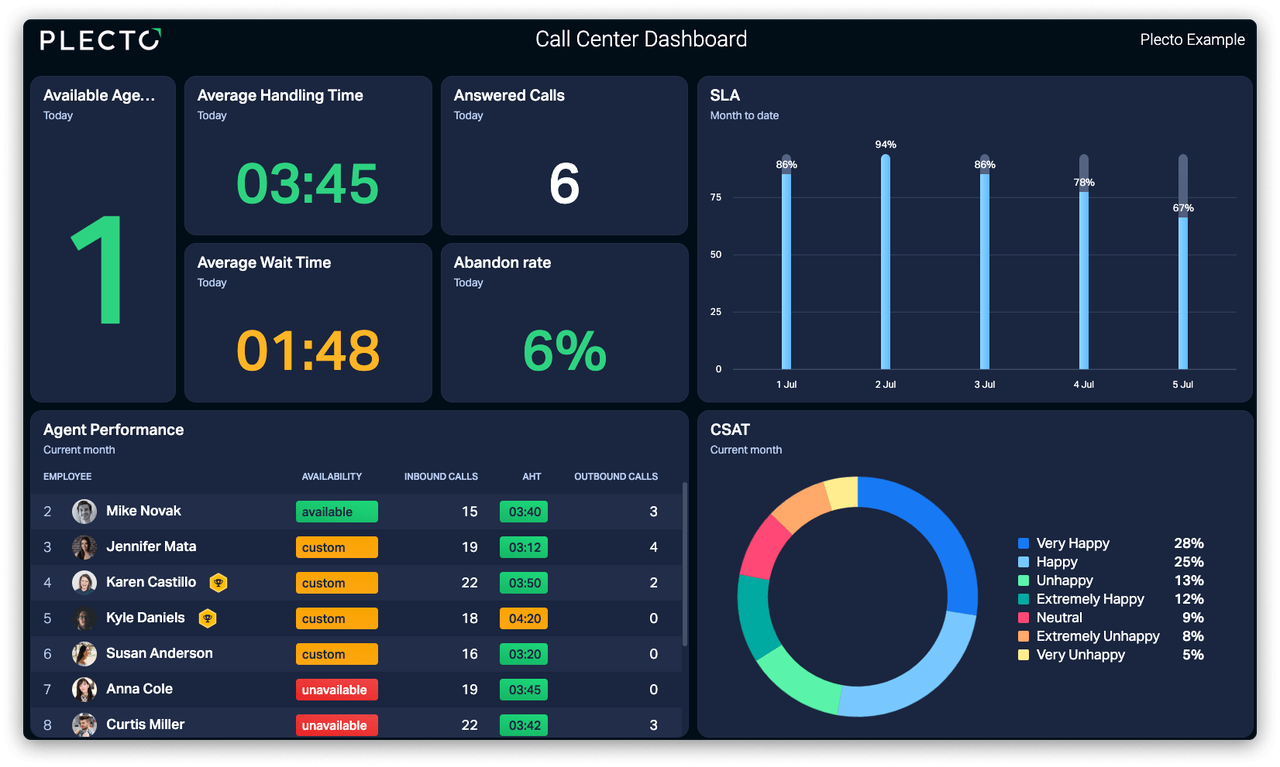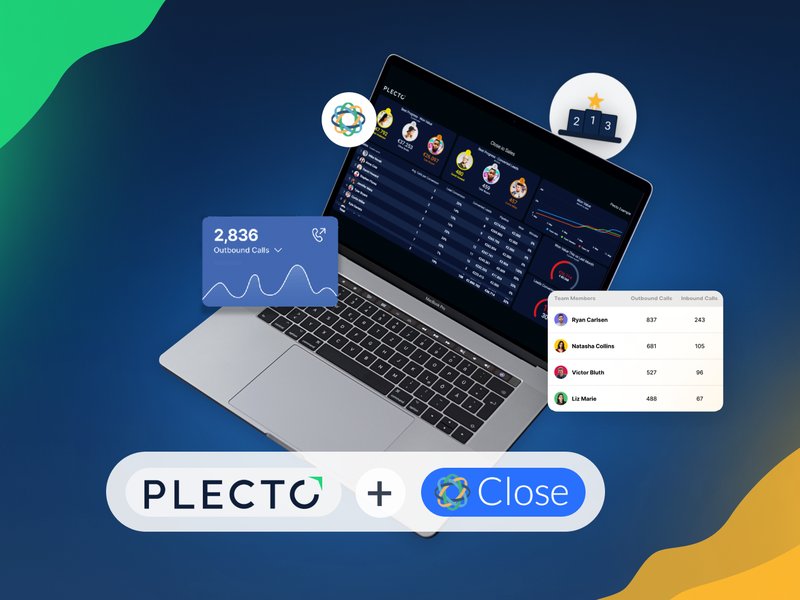The concept of SMART goals is polarizing. Many business gurus will dwell on the benefits of setting realistic, manageable goals. Conversely, others insist that they may be too narrow and inflexible.
Regardless of your stance, there’s no arguing how effective the concept can be at achieving success (when done right). After all, this strategy ensures you’re not just shooting in the dark. Instead, you’re creating an action plan with parameters that edge your team toward its targets.
This article will discuss five steps to setting SMART goals for your call center team. But first, let’s consider what the idea could look like for you.
What are SMART goals?
Whether you run a niche call service center, crypto startup, or multibillion-dollar conglomerate, goals are essential for driving success.
But as Zig Ziglar once pointed out, “A goal properly set is halfway reached.” Ergo, it’s not just about having them — how they are set plays a major role in the outcomes.
That’s why SMART goals are so crucial. They are:
- Specific: Your target should be as clear-cut and precise as possible.
- Measurable: Efforts and success must be quantifiable and trackable.
- Achievable: Sure, goals should be challenging. But they must also be realistic.
- Relevant: They must fit in with your overall objectives.
- Time-bound: No, a goal with no deadline in sight does not cut it.
You can align the above framework with any goals you need your teams to reach within a specific period of time.
Why do call center teams need to set goals?
Call centers manage customer inquiries, resolve issues, and provide necessary support. They play a vital role in delivering a positive customer experience.

With that in mind, goals ensure that your teams sync their efforts and improve the quality of their service.
Picture a bustling center with a team of agents sitting at their workstations and fielding loads of customer calls throughout the day. While this paints an image of dedication, the call center manager discovers — from analysis — that vital key performance indicators (KPIs) are not being met. Obviously, there’s a problem.
The solution? A concerted, realistic plan to address the issue and perform significantly better by the next set time frame. In other words, a SMART goal.
How to set call center SMART goals
Let’s take a closer look at the steps to set SMART goals in your call center teams. Each concept comes with practical tips you should incorporate into your framework for the best results.
1. Define clear and specific objectives
Any goals must be as unambiguous as possible. In other words, there should be no vagueness that could erode the understanding of what needs to be done.
For instance, simply planning to “increase customer satisfaction” doesn’t cut it. Because there’s so much involved, such a goal lacks the clarity and focus your teams need to effectively channel their efforts.
So to ensure you set out clear goals, keep the following in mind:
- Reflect on your priorities: What is the performance indicator that needs working on? It could be anything from your average handle time (AHT) to your first call resolution (FCR) rate or sales conversion rate.
- Ask critical questions: Who is the goal for? What does it seek to accomplish? What will it address? Where will we work on it? Who will the process involve?
- Consider avenues for improvement: This might include VoIP for call center solutions, a recruitment drive, or new team leaders.
When you’re satisfied, you’ll be armed with razor-sharp focus to proceed.
Build your first dashboard.
Start your 14-day free trial today
2. Quantify progress and success
If your goal is not measurable, there’s no objective means of tracking its progress. Plus, you cannot evaluate its journey. SMART goals provide a clear indication of success.
Remember that goal that we considered vague? Instead of simply trying to “improve customer satisfaction,” you could set out to “increase CSAT by 10% within six months.” Now, there’s a goal that you can track and make objective appraisals on.
Answering these questions will help you achieve this:
- What KPIs will be used to measure progress?
- How will progress be tracked?
- What is the target for each KPI?
- What are the milestones along the way?

While reviewing data to access processes, make necessary adjustments to your strategy or resource allocation to keep you on track.
3. Set realistic and attainable goals
You may have heard of HARD goals. The key contrasting concept between that and SMART goals is that they are difficult and intended to produce extraordinary results. On the other hand, the SMART goals you set for your call center teams must be realistic.
Granted, they shouldn’t be so easy that they erode any sense of accomplishment. But also shouldn’t be so challenging that they squash motivation and burden your team.
For instance, if you’re barely managing communications with your globally distributed team, expecting a massive reduction in customer wait times is hardly attainable.
Plus, if your call center's average call handling time is 10 minutes, setting a goal to reduce the metric to five minutes within one month is overly ambitious. Instead, a more realistic goal would be to reduce it to eight minutes within two months.
So, consider the available resources and your team’s capabilities. Break down large goals into smaller, more manageable goals to make them less daunting. Set milestones to provide a sense of accomplishment along the way.
Remember to involve the team in the goal-setting process. This will help ensure your agents are committed to achieving the goals.
4. Align goals with your overall objectives
Any goals you set should align with the call center’s objectives. In other words, they must be relevant to the big picture.
For example, say you bought a new website domain on OnlyDomains and you want to increase the amount of traffic your new site is seeing. This would be a company-wide goal that works best if you have multiple teams working towards it. Whether it’s your social team adding lots of new linked content or your call center staff directing people towards the site their coordinated efforts will make a big difference.
It goes beyond that though. Relevant goals provide a clear sense of purpose. When your team members understand the impact of their efforts in the long term, they gain a sense of significance in their work, and this will cycle back into renewed effort.
Review strategic objectives and identify the focus areas where improvements will equal significant outcomes. Connect the dots from there to the overall customer experience.
5. Set timelines for accountability
Time-bound goals have a specific deadline. They ensure accountability and create a sense of urgency. In turn, that ensures agents stay focused on achieving their goals.

A goal to reduce the average call-handling time by 10% sounds great. But what happens if there’s no set time to achieve it? Procrastination creeps in, motivation decreases, and you’re unable to track progress, if there is any.
Consider these questions while setting deadlines:
- What is a realistic timeframe for achieving the goal?
- What are the milestones along the way?
- How will progress be tracked?
Based on your answers, you can set a deadline that’s neither too lenient nor aggressive to keep the team focused and motivated.
Remember deadlines don’t need to be set in stone. Constantly track progress and make adjustments to the time limit if necessary.
What do call center SMART goals look like?
Now you have a game plan for setting SMART goals for your call center teams, let’s consider a practical example.
Say your website only offers static information and contact forms. Consequently, you’ve found that customers may experience delays in receiving responses to their inquiries.
Here’s how you may set a SMART goal to address this.
- Specific: Enhance customer engagement and support by implementing a communications API to enable real-time chat functionality on the website within the next three months.
- Measurable: Measure customer satisfaction scores related to website interactions. Increase the results by 20% within three months.
- Achievable: Identify and integrate a reliable communications API provider like Vonage, ensuring seamless integration with the website's existing infrastructure and customer support systems.
- Relevant: This goal aligns with your call center's objective of providing prompt and convenient customer support options and enhancing customer engagement.
- Time-bound: Have the real-time chat functionality fully implemented and operational on the company website within three months. Allow sufficient time for development, testing, and training.
As you can see, this SMART goal has a clear roadmap for implementation. What’s more, it enables the team to track progress and measure impact on the associated metric – CSAT, in this case.

Mistakes to avoid
If you follow the above steps, you’ll be drumming up SMART goals for your teams in no time. However, there are pitfalls to avoid in the process. Here’s a checklist of things not to do when setting your goals.
- Don’t exclude team involvement in the goal-setting process. Encouraging contribution and valuing opinions is vital for employee engagement and retention.
- Don't fail to regularly review and adjust goals. Continuously monitor progress and make necessary adaptations.
- Don't communicate goals with little clarity. It can lead to misunderstandings and confusion.
- Don't solely focus on quantitative metrics. Qualitative aspects like your team’s morale are equally as crucial.
- Don't overload the team with too many goals simultaneously. Focus on a manageable number.
- Don't be rigid. Embrace flexibility to adjust goals in response to changing situations.
- Don't neglect milestones and achievements; they are essential for employee motivation.
- Don't overlook regular monitoring; establish a system to track progress.
- Don't forget to provide your team with the necessary tools, training, and assistance.
Key takeaway
The SMART goal framework drives performance and efficiency in your call center teams. When planned and implemented correctly, it ultimately results in increased customer satisfaction – the overarching objective for any customer support center.
While implementing this framework, focus on the steps outlined above to help your team crush its goals and achieve success.
Ryan is an award-winning copywriter, with 20+ years of experience working alongside major US brands, emerging start-ups, and leading tech enterprises. His copy and creative have helped companies in the B2B marketing, education, and software sectors reach new customer bases and enjoy improved results. Here is his LinkedIn.




